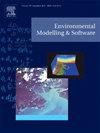Interpolation of missing ozone data using graph machine learning and parameter analysis through eXplainable artificial intelligence comparison
IF 4.8
2区 环境科学与生态学
Q1 COMPUTER SCIENCE, INTERDISCIPLINARY APPLICATIONS
引用次数: 0
Abstract
Ozone (O3), a short-lived climate pollutant, continues to increase despite policies aimed at suppressing its precursors in South Korea. The government operates approximately 500 observatories to monitor O3 and trace gases. Researchers use these data to address the ongoing issue of increasing O3 levels. However, challenges in data retrieval from observatories may introduce biases in O3 studies. In this study, we developed a graph-based machine learning model to simulate missing O3 concentrations for mitigate bias. The model incorporates spatiotemporal distribution characteristics using a merged observation dataset from South Korea in 2021. Regardless of region or length of missing data, the model effectively simulates O3 variations with R2 of up to 0.9 and RMSE of 3.6. To determine the influence of input parameters on O3 interpolation, we used eXplainable AI methods. The results indicated that NO2 is the most important factor in cities, while photochemical indicators are more influential in provinces.
通过可解释的人工智能比较,使用图形机器学习和参数分析来插值缺失的臭氧数据
臭氧(O3)是一种短期的气候污染物,尽管韩国的政策旨在抑制其前体,但臭氧(O3)仍在继续增加。政府运营着大约500个观测站来监测臭氧和微量气体。研究人员利用这些数据来解决臭氧水平不断上升的问题。然而,来自观测站的数据检索方面的挑战可能会在O3研究中引入偏差。在这项研究中,我们开发了一个基于图的机器学习模型来模拟缺失的O3浓度,以减轻偏差。该模型利用2021年韩国的合并观测数据集整合了时空分布特征。无论缺失数据的区域或长度如何,该模型都能有效地模拟O3的变化,R2高达0.9,RMSE为3.6。为了确定输入参数对O3插值的影响,我们使用了eXplainable AI方法。结果表明,NO2是城市最重要的影响因子,光化学指标对省份的影响更大。
本文章由计算机程序翻译,如有差异,请以英文原文为准。
求助全文
约1分钟内获得全文
求助全文
来源期刊

Environmental Modelling & Software
工程技术-工程:环境
CiteScore
9.30
自引率
8.20%
发文量
241
审稿时长
60 days
期刊介绍:
Environmental Modelling & Software publishes contributions, in the form of research articles, reviews and short communications, on recent advances in environmental modelling and/or software. The aim is to improve our capacity to represent, understand, predict or manage the behaviour of environmental systems at all practical scales, and to communicate those improvements to a wide scientific and professional audience.
 求助内容:
求助内容: 应助结果提醒方式:
应助结果提醒方式:


